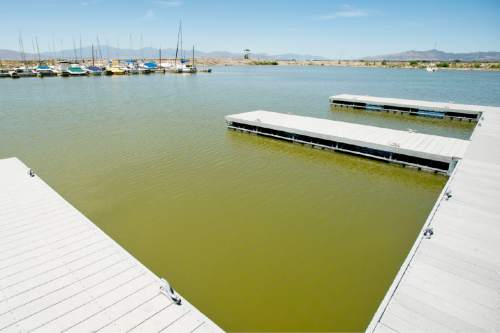This is an archived article that was published on sltrib.com in 2015, and information in the article may be outdated. It is provided only for personal research purposes and may not be reprinted.
Phase one of a new study backed by the state Division of Water Quality will kick off on Tuesday to investigate phosphorus and nitrogen nutrient levels in Utah Lake and the effects on recreation, aquatic life and agricultural use.
Too many nutrients can contribute to algal blooms, which could harm the health of organisms that depend on the lake as a water source.
Erica Gaddis, an assistant director at the agency, said this type of assessment is routine for lakes across the state, but this one will be a "much more in-depth study."
"Instead of just looking at a handful of data points, we'll look at a much larger data set and look at it in the context of when fish are breeding and when people are actually out there water skiing and give it a little bit more study," she said.
She said the study will not affect access to the lake and will be done in partnership with Utah State Parks and Recreation, the Utah Lake Commission and others.
"All of the studying we're doing, we don't want to overly worry people," she said. "We don't want people to stop using Utah Lake. We just want to preserve it and protect it for the future."
Nathan Schwebach, the public information officer for State Parks, echoed Gaddis' sentiment that recreational users of the lake shouldn't be too concerned.
"If you look at the size of Utah Lake, it is so massive that we may have a small issue in one part of the lake, but it may only be impacting 1 percent of the body of water," he said.
The study will also revise load calculation, meaning it will give an update on the quantity of nutrients in the lake and determine where they come from. Gaddis said previous studies have left wastewater treatment plants "unhappy" with the method of calculation.
"They have some fair critiques, and so we're going to revise that with some of their input based on the most recent data," Gaddis said.
A third aspect to phase one is to develop a model that can simulate the relationship among nutrients, algae and oxygen in Utah Lake, she said, so researchers can test how alternative scenarios might affect the lake.
Gaddis said people conducting the study plan to produce a data-gap summary at the end of phase one, identifying "what [information] we don't know and what we need to go get."
This project is important, she said, because nutrients have a complex but real effect on aquatic life and recreation use.
"We don't have any [water-quality] nutrient standards in Utah right now, and to do it right, we feel like we need to do it site by site or water body by water body so that we don't just blanket apply the same number everywhere," she said.
The Division of Water Quality intends to look at other water bodies, like the Jordan River and the Great Salt Lake, sometime down the road, but she said the agency chose to examine Utah Lake first because it's frequently used by people, is located in one of the largest areas for growth in the state and affects the dynamics of other bodies of water in the system.
"Any problems we're seeing right now are going to get worse as growth continues," Gaddis said, adding that policies often take years to implement. "So we want to start now."
"I think our biggest challenge will be, as our study moves forward, that it will collaborate with some of the other studies that are going on and that we don't get into sort of a combat-science situation," she said. "We don't want that."
She said she anticipates some concern from the regulated community because the study's outcome could result in permit limits for nutrients, which may reveal a need to upgrade those treatment plants.
"That will, of course, cost money, and that will, of course, cause people to be concerned," she said. Utah has been given flexibility by the Environmental Protection Agency on how to go about managing nutrients, and these site-specific studies are part of the state's chosen method.
Gaddis said in addition to the research, regulators are implementing technology-based phosphorus limits by using low-cost equipment attached to treatment plants, which significantly reduces the phosphorus output.
Treatment plants will be required to implement this technology by the year 2020.
"What Utah's selected is an adaptive approach, where we make some reasonable reductions now and do our science right. We want to be able to maintain that adaptive approach," she said. "If we lose our tech-based phosphorus rule or if we don't make progress on some of these really important waters, we may be put in a position where we have to do something less adaptive, less creative."
Phase one is predicted to be completed within a year, and Gaddis said researchers hope to begin phase two sometime next summer.
Depending on what they find, Gaddis said one alternative is a "full TMDL analysis."
"It's basically where you do a more detailed source analysis and figure out exactly how much [nutrient] is coming from where, and you set a target endpoint for the lake, and then you require those reductions to meet that target," she said.
Another alternative, which she said is less likely, is reclassifying the lake for different recreational purposes in case researchers find that the current state of Utah Lake is "natural" and that algal blooms aren't related to conditional nutrient loading.
The third option is similar to the first, but "a little bit higher bar in terms of getting EPA's approval because it becomes a formal standard that we can regulate under the lake," Gaddis said.



